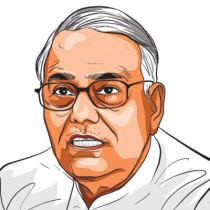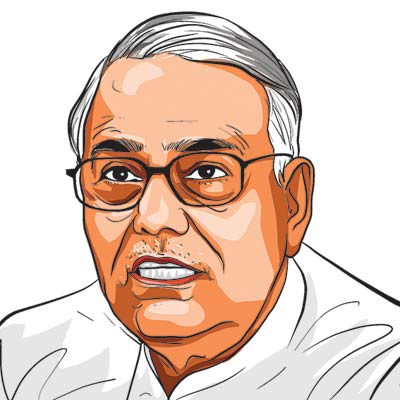Not a good and simple tax
Government needs to introduce three rates for GST and push for a single one in the long run

Multiplicity of rates leads to classification disputes, unnecessary litigation and avoidable corruption. (Express photo: Prem Nath Pandey/File)
The prime minister has put paid to all hopes of the Goods and Services Tax (GST) ultimately moving to a single rate. The acting finance minister has been even more emphatic in rejecting the idea which he has dismissed as ridiculous. Earlier, spokespersons of the government including the former finance minister, who is today minister without portfolio, had stated that the aim of the government was to ultimately move to a single rate. The PM has clarified that Mercedes and milk cannot have a single rate.
Taxation is based on a philosophy of taxation. It is not, and should not be, dependent on the whim and caprice of the government of the day. Unfortunately, in our country the philosophy of taxation has never been clearly defined and therefore all taxes have been subject to such whim and caprice. The GST, unfortunately, has also become its victim. In saying that Mercedes and milk cannot be taxed at the same rate, the prime minister has given an indication of the taxation philosophy he has in mind. He wants to use an indirect tax like the GST as a tool of social justice. The alternative view is indirect taxes, which are complicated to administer, should not be used as an instrument of social justice; this purpose should be achieved by direct taxes under which the better-off people can be taxed at a higher rate and the not-so better-off at a lower rate.
When I became Union finance minister in 1998, I faced the same predicament. Chidambaram before me had already introduced three rates of income tax. I found them reasonable and therefore, did not interfere with them in all the five budgets that I presented between 1998 and 2002. Some tweaking did take place here and there to meet the needs of emerging situations, but these were confined to imposition of surcharges and cesses. I did not touch the IT rates of 10 per cent, 20 per cent and 30 per cent.
As far as indirect taxes were concerned, I noticed that there were 11 to 12 different rates of central excise. In my first budget of 1998, I imposed a duty on branded products (edible). Mithai (sweetmeats) come under the mischief of central excise as a result of this decision. Mithai makers from all over the country descended upon me after the presentation of the budget. Their argument was simple. If they packed the sweets in a box, which carried their brand name, then that box would be subject to tax. On the other hand, if they packed the sweet in unmarked boxes they will not be subject to this tax. Their point was straight and simple. It would be easy to evade the tax; it would not add any substantial revenue to the government’s kitty but would lead to tremendous harassment by the excise officials. I realised the merit of their argument and withdrew the levy, but in the process learnt a very important lesson.
Multiplicity of rates leads to classification disputes, unnecessary litigation and avoidable corruption. Every taxpayer wants to be taxed at the lower rate and lobbies for it. This creates a fertile ground for lobbyists to operate.
After this experience, I decided to rationalise the rates. I knew that if I did not have a philosophy to justify what I was doing, I would not be able to carry conviction with the stakeholders. I also realised that the justification had to be simple enough to be understood by everyone. I also had the idea of social justice in mind so I decided to have three rates of central excise instead of the existing multiple rates. There would be a mean rate, a merit rate and a demerit rate. Of course, some items would be zero-rated as well. Compressing a dozen rates of excise into three rates was not easy. But in 2002, when I presented my fifth and last budget, and finally introduced central VAT in place of central excise, I was able to bring almost all items under these three rates. All lobbying stopped immediately; nobody could quarrel with the philosophy behind the move and I did not face any protests.
Meanwhile, I was also convinced that it was unwise to use indirect taxes as the preferred instrument to achieve social justice, which should in any case be done through direct taxes. Therefore, I declared my intent to finally move to a single rate. The foundation of GST was thus firmly laid in 2002.
I was appalled, therefore, when I found that GST, which was introduced with such fanfare on July 1 last year, had five rates and many cesses. It was clearly not a good and simple tax as the PM claimed in his “tryst with GST” speech on the midnight of June 30 last year. No wonder, GST has turned out to be as messy as our independence was, with the country divided on religious lines and the communal holocaust that followed.
My three-rate formula for central VAT was already in place when GST was under consideration. The finance minister should have been aware of it, exercised his leadership role and carried conviction in the GST council for the existing three rates. Over 90 per cent of the excisable items were already under the mean rate of 16 per cent by the time I demitted office in 2002. There could have been a small list of merit goods at 8 per cent and another small list of demerit goods at 24 per cent. It appears that nobody in the government had any idea of what had already been achieved and like Radcliffe, drew a dividing line which was completely arbitrary. There have been perhaps more than 100 amendments in GST in the last one year, both of rates as well as of the procedure prescribed. Amit Mitra, the finance minister of West Bengal, is spot on when he says that GST was thrust upon an unprepared nation, and may I add, by an unprepared government.
So Mr Prime Minister, please clean up your act, introduce three rates for GST and declare that we shall move ultimately to one rate. Then, and then alone, we shall be able to say confidently that GST is indeed a good and simple tax.
The writer is a former Union finance minister
For all the latest Opinion News, download Indian Express App
More From Yashwant Sinha
- Dear friend, speak upThe government has now completed nearly four years in office, presented five budgets and used up all the opportunity available to it to show results...
- More manifesto, less budgetAn increasing revenue deficit and half-cooked schemes marked Budget 2018. There was no accounting for the two major programmes it announced...
- I need to speak up nowYashwant Sinha writes: The economy is on a downward spiral, is poised for a hard landing. Many in the BJP know it but do not…







































No hay comentarios:
Publicar un comentario